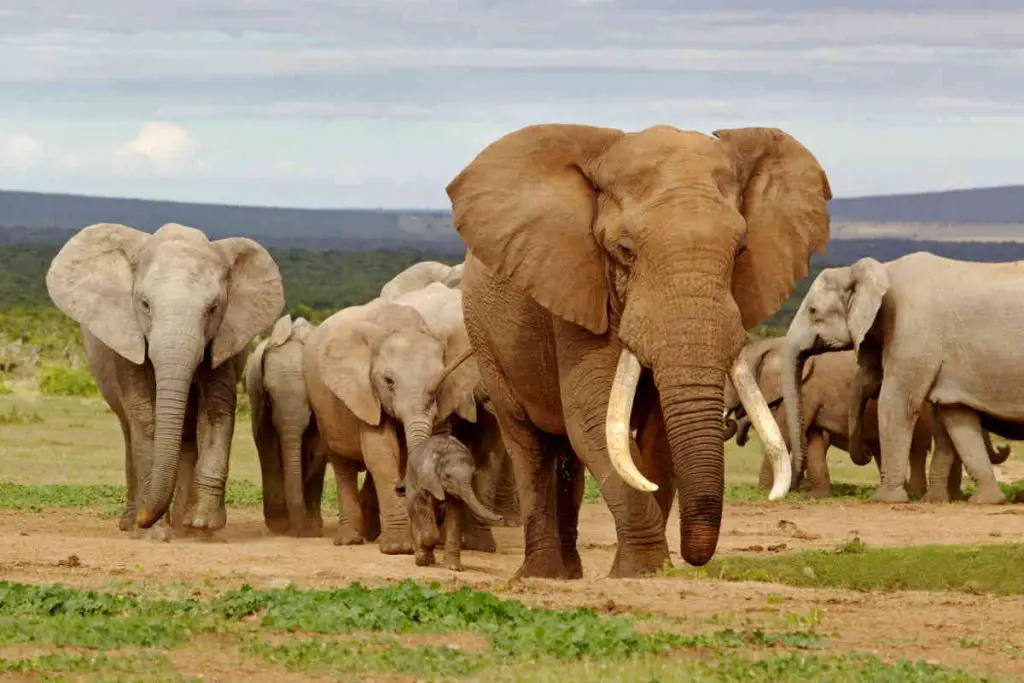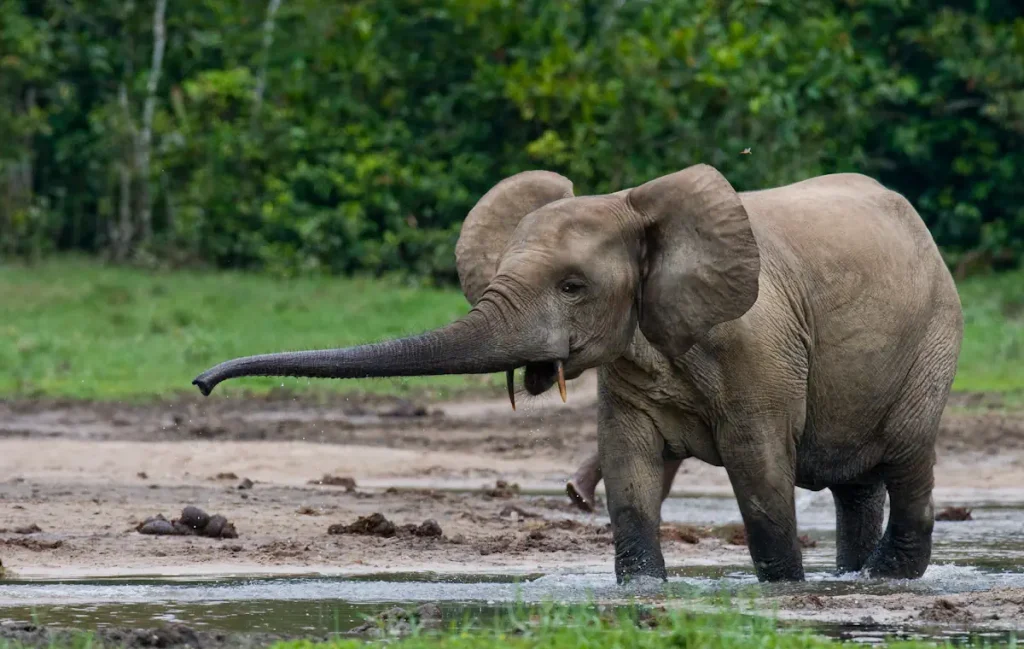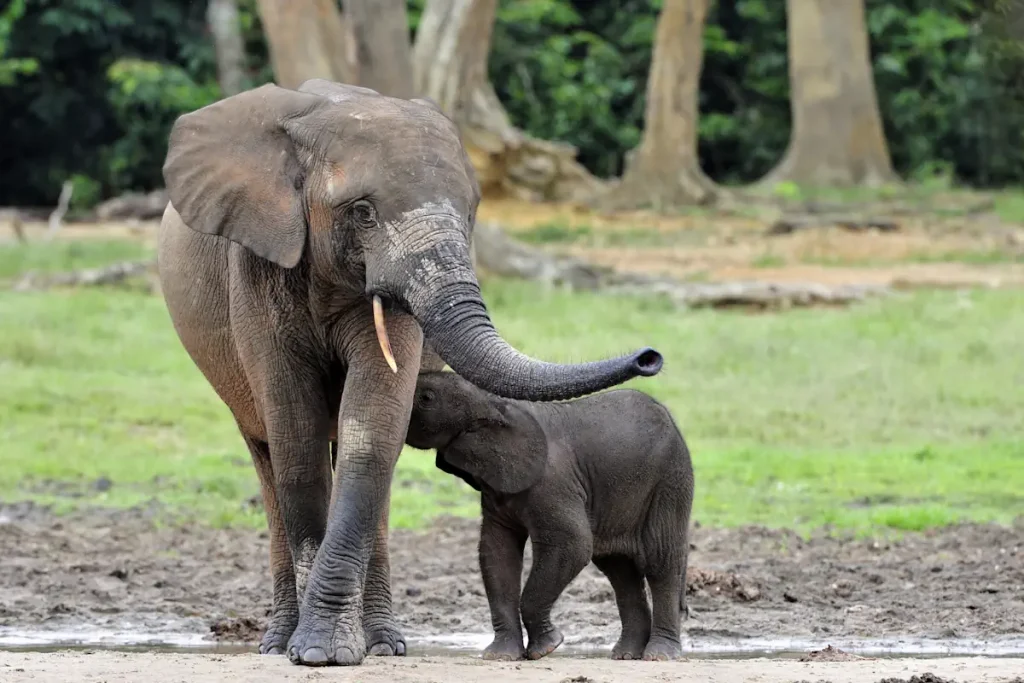There are two distinct species that roam the diverse landscapes of Africa: the African Bush Elephant (Loxodonta africana) and the African Forest Elephant (Loxodonta cyclotis). Despite sharing a common heritage, these two species have evolved to adapt to their specific habitats, leading to striking differences in their physical attributes, diet, social behavior, and more.
Understanding these two distinct species provides a glimpse into the fascinating world of elephants and their varied adaptations to life in Africa. They epitomize the incredible diversity within the animal kingdom and underscore how species evolve to suit their environment. While they may share a common ancestor, their journey through time has led to unique physical and behavioral traits that set them apart.
Differences between the African Bush Elephant and the African Forest Elephant
1. Size [African Bush Elephants are bigger]
African Bush Elephants, known as the giants of the African savannah, typically tower over their forest-dwelling counterparts. They are notably larger, usually standing a formidable 3 to 4 meters (about 10-13 feet) tall at the shoulder. On the other hand, the African Forest Elephants, perfectly adapted to their dense forest habitats, possess a more compact stature. Adults of this species typically reach heights between 1.8 and 2.4 meters (approximately 6-8 feet) at the shoulder.
The largest recorded African Bush Elephant, Henry, stood over 13 feet (3.96 meters) tall – larger than any elephant known to be living today. He was about 11 tons in weight.

2. Weight
African Bush Elephants are heavier, with males weighing up to 6-7 tons, whereas Forest Elephants usually weigh up to 2-4 tons.
3. Tusks
Forest Elephants have straighter, downward-pointing tusks, which help them move through dense forest vegetation. African Bush Elephants have larger, curvier tusks.

4. Ears
The ears of the Forest Elephant are more oval-shaped, while the Bush Elephant’s ears are larger and more fan-shaped.
5. Skin
Forest Elephants often have hairier bodies and longer tails compared to Bush Elephants.
6. Head shape
Forest Elephants have a more rounded head and forehead, whereas the Bush Elephant’s head has a twin-domed shape with an indentation in the middle.
7. Foot Shape
African Forest Elephants have rounder feet compared to the more oval-shaped feet of African Bush Elephants. This difference aids Forest Elephants in navigating dense, uneven forest terrain.

8. Diet
Bush Elephants prefer grasses, shrubs, and tree branches, while Forest Elephants have a diet that includes a higher proportion of fruit, leaves, and bark.
9. Habitat
As their names suggest, Bush Elephants typically inhabit the savannahs, plains, and deserts of Africa, while Forest Elephants live in the dense rainforests of central and western Africa.
10. Social structure
In elephant societies, family groups are the fundamental social units. However, the size and structure of these groups can vary based on species.
African Bush Elephants, or Savannah Elephants, usually form larger family groups that are tightly knit. These groups often consist of related females (mothers, daughters, sisters, and aunts) and their young offspring. The matriarch, usually the oldest and largest female, leads the group and makes decisions about where to forage, when to rest, and how to avoid danger. The bonds within these groups are strong, and members show sophisticated cooperation and empathy.
On the other hand, African Forest Elephants tend to form smaller family groups. This is likely an adaptation to their dense forest habitat, where a larger group might find it challenging to move and forage effectively. These groups, like those of the Bush Elephants, are matriarchal but tend to be less cohesive. Forest elephants frequently exhibit fission-fusion dynamics, where group size and composition change over time. For instance, at times, a group might split into smaller units to exploit different foraging opportunities and later merge back.

11. Lifespan:
Forest Elephants, in general, have a slightly longer lifespan compared to their Bush counterparts, primarily due to lesser threats from predators in their forested environment.
African Bush Elephants in the wild typically live to be around 60-70 years old. African Forest Elephants, on the other hand, often live slightly longer, with many reaching their 70s or 80s.
12. Reproduction
Forest Elephants tend to reproduce less frequently than Bush Elephants. The age of first reproduction for Forest Elephants can be as late as 23 years for females, compared to around 12 years for Bush Elephants.

13. Role in Ecosystem
Forest Elephants are known as “forest gardeners” due to their role in maintaining biodiversity by dispersing seeds through their dung. While Bush Elephants also play a crucial ecological role, they are more often seen as “engineers” of the landscape, able to change scrubland into grassland, thereby shaping their habitat.
14. Behavioral Differences
Forest Elephants are generally more secretive and less aggressive than their savannah counterparts. This is likely an adaptation to their dense forest habitat, which requires different behaviors compared to the open plains and savannahs where Bush Elephants live.
15. Sound Frequency
Forest elephants communicate using lower-frequency sounds compared to Bush Elephants. This adaptation allows their calls to travel more effectively in a dense forest environment. Bush Elephants also use low-frequency sounds, but their range of communication frequencies is generally higher, which works better in the more open savannah environment. This difference is an excellent example of how each species has adapted to its specific habitat.

Related: 20 Amazing Elephant Facts
Genetic Differences between the African Forest Elephant and the African Bush Elephant
The genetic differences between African forest elephants and African savannah elephants were not fully recognized until the advent of more advanced DNA analysis techniques in the late 20th and early 21st centuries.
Previously, forest and savannah elephants were considered to be different subspecies of the same species, Loxodonta africana. However, genetic studies conducted in the last few decades revealed that the forest and savannah elephants diverged from a common ancestor between 2.6 and 5.6 million years ago. This is roughly the same time when Asian elephants (Elephas maximus) and woolly mammoths (Mammuthus primigenius) diverged from their common ancestor.
This genetic difference is significant because it suggests that forest and savannah elephants have evolved separately for a long time, long enough to become two different species: Loxodonta cyclotis (Forest Elephant) and Loxodonta africana (Savannah Elephant). This has implications for conservation because it means there is even more biodiversity among elephants than previously recognized.
Conservation status
Both species are under threat due to habitat loss and poaching, particularly for their ivory. However, Forest Elephants have been hit particularly hard and are classified Since 2021, the species has been listed as Critically Endangered on the IUCN Red List, while the African Bush Elephant is considered Endangered after the global population was found to have decreased by more than 50% over 3 generations.
Sources
- African forest elephant on Wikipedia
- African bush elephant on Wikipedia
- Moon Landings: All-Time List [1966-2025] - February 2, 2025
- What Is Max-Q and Why Is It Important During Rocket Launches? - January 16, 2025
- Top 10 Tallest Rockets Ever Launched [2025 Update] - January 16, 2025

